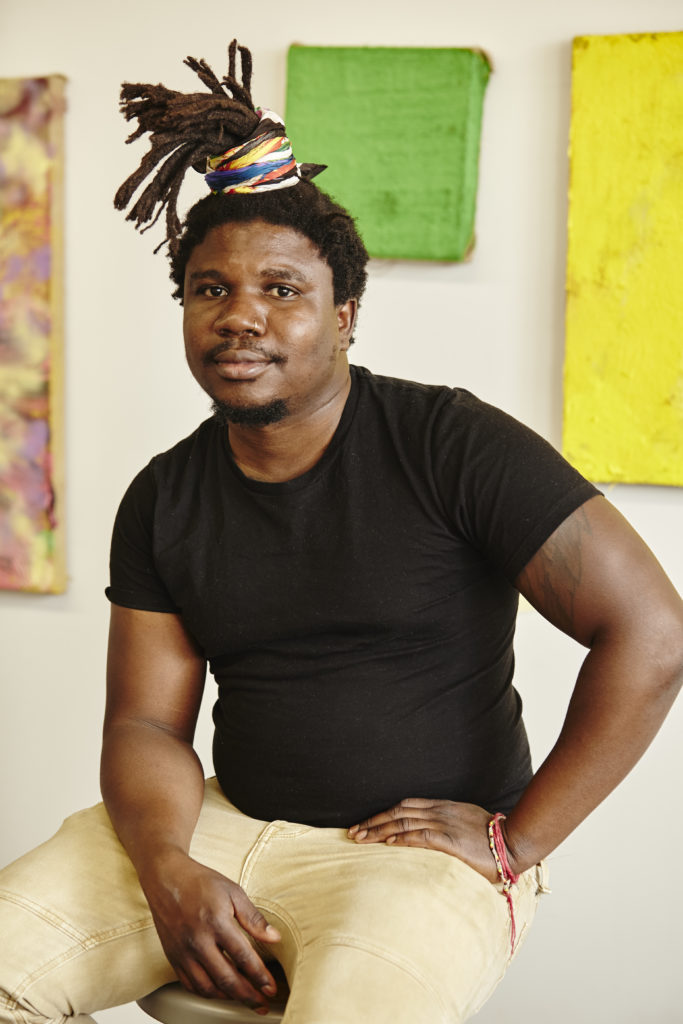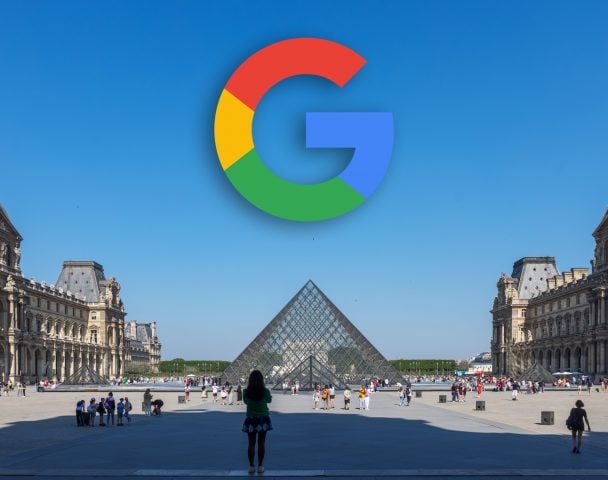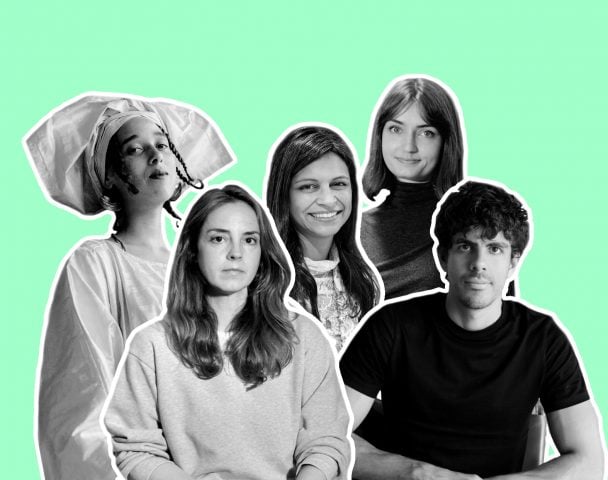It’s unusual to hear about an emerging artist who has 10 years’ worth of work already mapped out in his mind. It’s even more unusual to hear that that artist is rolling out his magnum opus at top galleries—just two and a half years out of art school. But 36-year-old Alvaro Barrington doesn’t let tradition dictate his career. In fact, he’s made it a point to break the rules.
Most surprisingly, Barrington insists on having collaborative representation with six different galleries, four of which are in London. He also combines his erudite art shows with spirited happenings outside the white cube, like backlot concerts, a pop-up jerk chicken stand, and a Caribbean carnival float.
Since he graduated from London’s renowned Slade School of Art in 2017, Barrington has rocketed from relative obscurity to the center of the city’s art scene, where he’s best known for his muscular canvases consisting of heavy paint on burlap. Though his works have not yet hit the open waters of the secondary market, his prices have been steadily rising and his schedule, growing increasingly packed. Prices now reach up to $60,000 and all the works at a recent exhibition at Sadie Coles HQ—who represents the artist alongside Blum & Poe, Thaddaeus Ropac, Corvi Morva, Emalin, and Mendes Wood DM—were on reserve days after it opened.
The Sadie Coles HQ show came on the heels of another exhibition that Barrington curated at Thaddaeus Ropac last summer and, the year before that, legendary art historian Sir Norman Rosenthal curated one of his first gallery shows, also at Ropac. This year is absolutely bustling for Barrington: He will have a solo booth with Sadie Coles HQ at Frieze Los Angeles next month; his co-curated show “Artists I Steal From” sees a new iteration at Mendes Wood in New York; Emalin will relaunch a music-based summer event series organized by Barrington; and he will have a solo shows at Corvi Mora and Ropac Paris in September. There will also be more carnival, more street parties, more dancing.
In a market that’s been known to milk young artists and leave them dry, how has Barrington taken such impressive control of his career, and avoided the kind of pressure and burnout that has plagued so many of his peers?
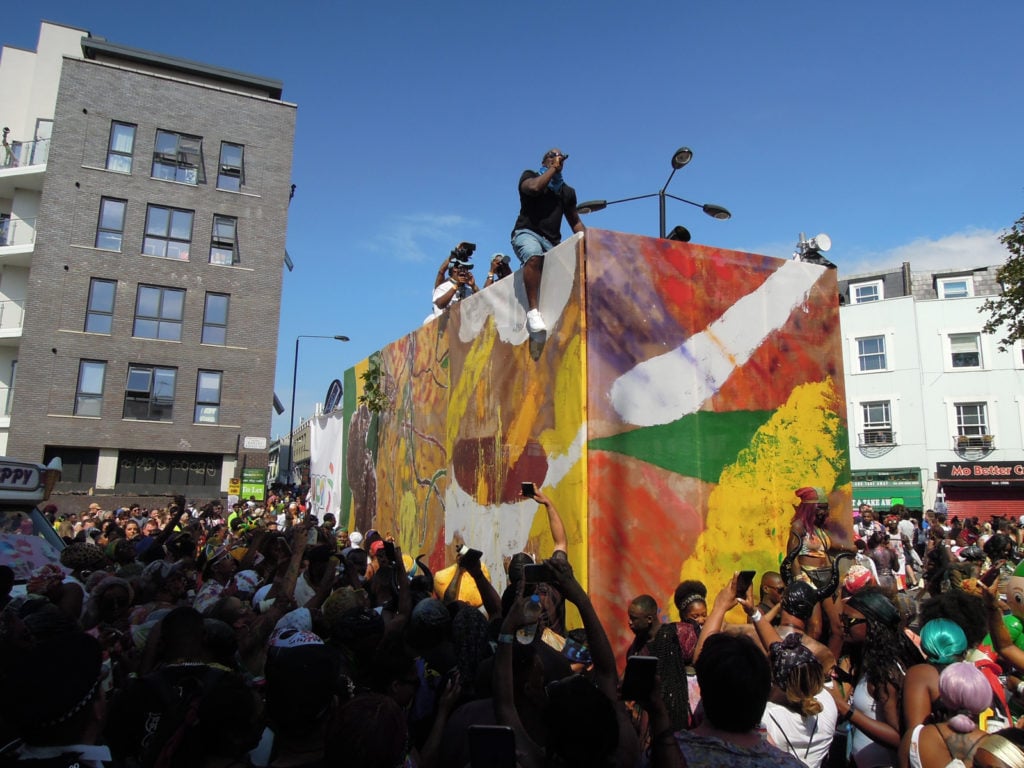
Alvaro Barrington’s Float for the Notting Hill Carnival. Photo by Florain Reither.
A Non-Monogamous Arrangement
On a recent autumn day, Barrington shows up to meet me at Emalin gallery on his beloved red Brompton bike. We stroll over and sit down for lunch where he listens intently to my questions and answers slowly, exuding sincerity and warmth while ordering one coffee after another.
A deep well of references bubbles up: Albert Oehlen, Simone de Beauvoir, Tupac Shakur, Joseph Beuys, Ghostface Killah, Picasso. He has a blueprint, he says, of a decade’s worth of work already crystallized in his mind—and his galleries are on board to support him through it all. He’s already in the middle of a four-part show dedicated to the life of Jamaican activist Marcus Garvey, the next chapter of which is at Corvi-Mora in London. (“How do you know what you will be making 10 years down the line?” I ask. “The 20th century’s already been written,” Barrington answers.)
The Tupac song “Keep Ya Head Up” was the first piece of art that captured his attention. “He was real, honest, and spoke a lot of truths,” Barrington says. “He was so magical and it changed my life and gave me a lot of things to think about. Pac loved his community, he loved black people, and how complicated they were at a time where a lot of politicians, including black politicians, were asking for 13-year-old kids to be locked up forever.”

Installation view from Barrington’s “GARVEY SEX LOVE NUTURING FAMALAY” at Sadie Coles HQ. Photo: Robert Glowacki. © Alvaro Barrington
Born in Venezuela and raised in Grenada by his grandmother, Barrington eventually moved to Brooklyn to live among a community of “aunties” after his mother died when he was ten. There, he learned a key lesson about the need for togetherness in order to survive, an ethic he applies to everything he takes on—including the art market.
When I ask Barrington about the collaborative nature of his gallery representation, he talks to me about that love he experienced growing up. “Each one of those people in my community that raised me gave me something different, and something wonderful about myself that allows me to navigate the world,” Barrington says. “That situation provided a different freedom from other people who may have more stable relationships with the older people in their life.”
His romantic relationships have been polyamorous, too. “It’s all about encouraging who you want to be—that question always comes up somewhere along the way,” he says. “You have got to let go of a lot of ego in those situations.”
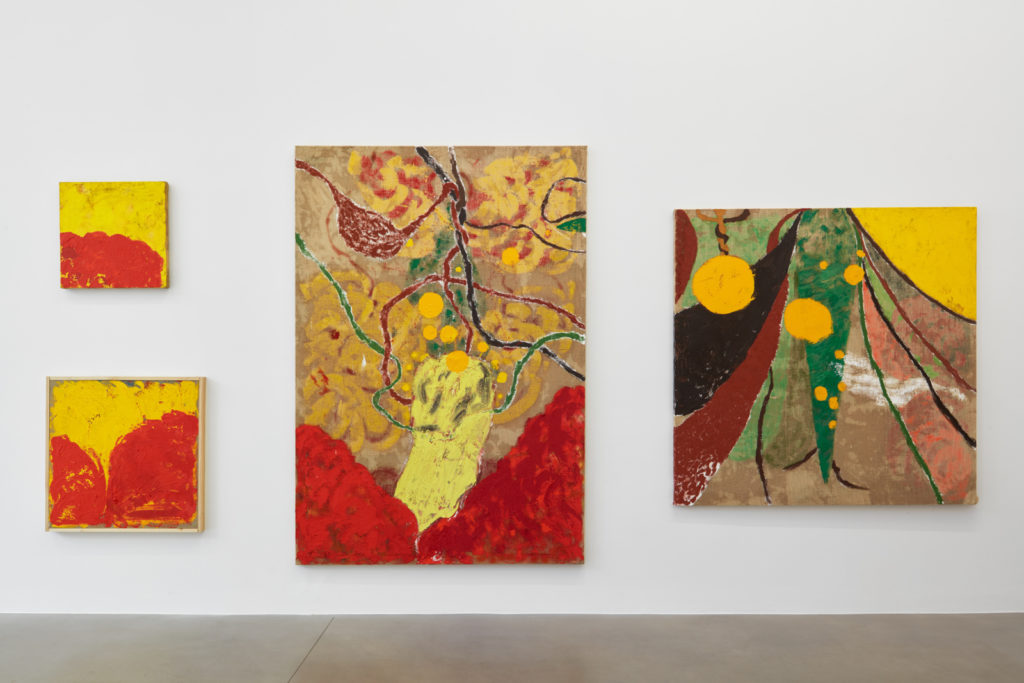
Installation view from Barrington’s “GARVEY SEX LOVE NUTURING FAMALAY” at Sadie Coles HQ. Photo: Robert Glowacki. © Alvaro Barrington
Ego is an interesting way to put it, especially when you flip the script and think about the situation for his dealers. One might initially suspect Barrington’s arrangement comes from having a strong ego—most artists command seven-figure prices and long waiting lists before they manage to shake loose from a gallery’s expectation of exclusivity (at least in the city where they are located). But every dealer I spoke to seemed to light up at Barrington’s fresh take on the typical artist-dealer relationship.
Thaddaeus Ropac says he has always been supportive of his artists working with more than just his gallery, and is happy to share Barrington with three other galleries in London. “As he says, it enables him to show a different part of himself, corresponding to each gallery’s identity,” Ropac tells me. “His connection with different collaborators and communities is integral to his practice and each gallery enables this in their own way.”
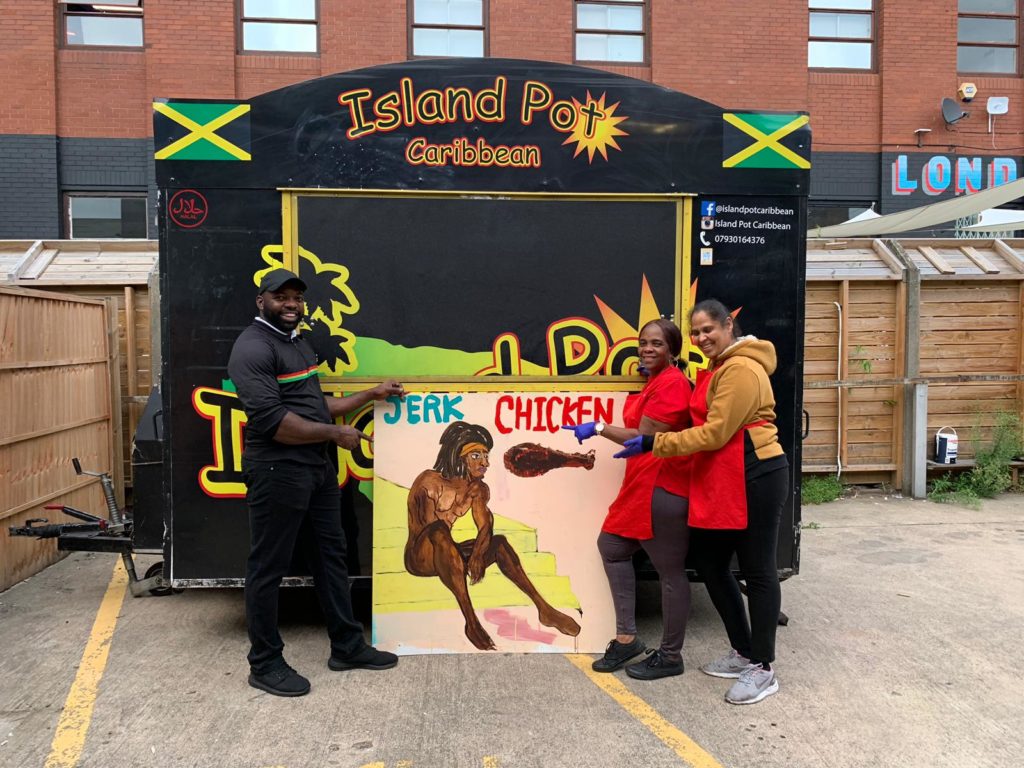
Island Pot at “Tall Boys A Double Shot Espresso” opening at Emalin. Photo courtesy of: Emalin, London
Auspicious Beginnings
Before he began working with Ropac, in April 2018, Barrington had his first show in London with Emalin, one of the more prominent young galleries in London known for its work with emerging Europe-based artists. As his career continues to take off in new directions, he tries to work with each gallery in a way that plays to their individual strengths. With Emalin, he organized a summer series of musical events that took place in their Shoreditch gallery, which culminated in a playful exhibition that included works by Tt X AB, the collaborative practice he shares with friend Teresa Farrell. It’s the kind of experimental, grassroots endeavor that wouldn’t quite suit a blue-chip gallery like Ropac.
Of course, Emalin benefits in its own way from its association with Barrington and his blue-chip dealers. “He is questioning what exclusive representation means,” says the gallery’s co-founder Angelina Volk. “It forces us all to think individually about what each gallery can do for an artist, and what these unique circumstances can collectively foster. Different kinds of galleries can provide different kinds of audiences, spaces, and conversations.”
Barrington implies that there may be a time in the future when things settle down for him. “I never wanted to be someone who allows the relationships through my art to determine what I can do in my art,” he says. “There are going to be moments where I might have to choose, make a commitment, and be responsible to it—like one day if I have a kid, I can’t be running around town like an asshole.”
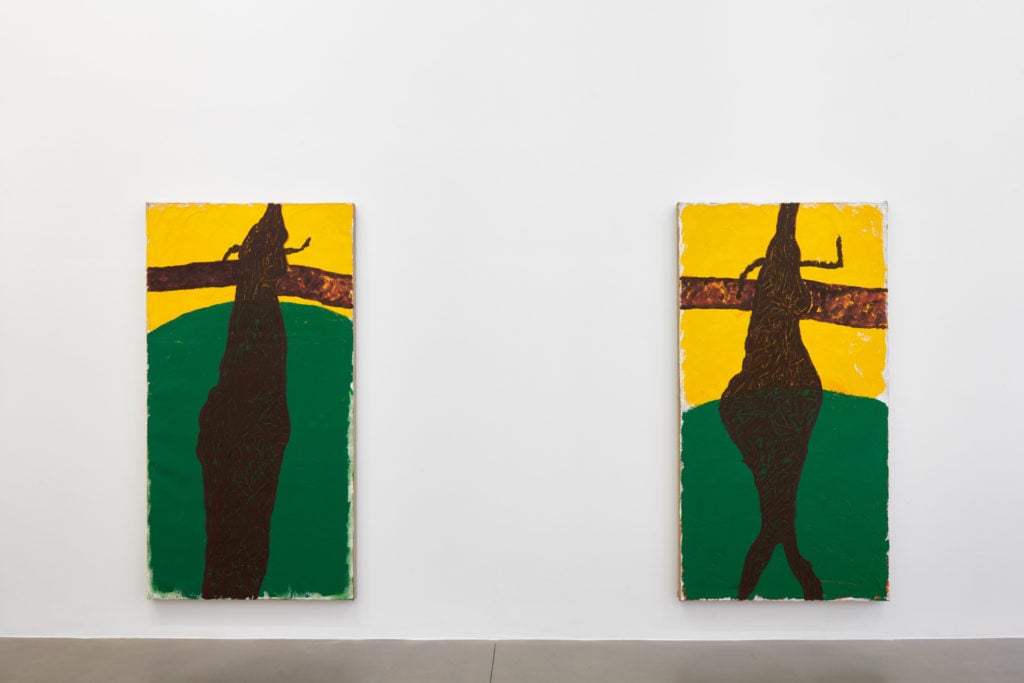
Installation view from Barrington’s “GARVEY SEX LOVE NUTURING FAMALAY” at Sadie Coles HQ. Photo: Robert Glowacki. © Alvaro Barrington
Strong Roots
Back over to Emalin, the two of us hover over a few of his works. His paintings look both earthy and alien, coded with rich references. Brash strokes are meticulously layered and planned out, sketch by sketch, before he touches his brush to the burlap canvases. He often sews thick panels of yarn onto his works. Perhaps what is most beautiful is how he manages to weave seemingly disparate references into something immediately coherent: He brings together West Coast rappers, fraught histories of the Black diaspora, and German postwar art history into a smooth mix. In one work from his collaboration with Farrell, a portrait of a seated man was part of her design for an A$AP Rocky music video before Barrington added a floating chicken leg and put it in the show.
A root-looking painting catches my attention; Barrington explains it’s part of an ongoing series about trees, inspired by German artist Albert Oehlen’s series of tree paintings, but also revolutionary American activist Assata Shakur, Tupac’s godmother who has been on the run from the FBI since 1977. “I imagine them as views she is looking at,” Barrington says.
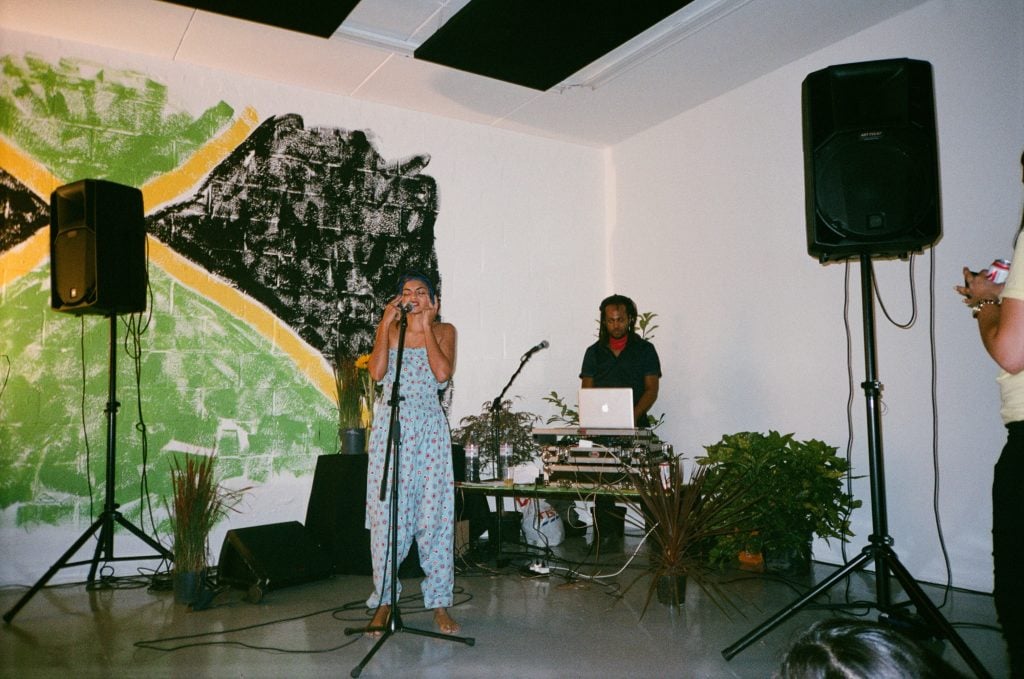
Performance view of 10K at Emalin, London. Photo courtesy of Melkorka Katrin.
At Sadie Coles HQ, alongside posters of Garvey, there are more of these treelike works, as well as dark brown roots and exploding hibiscus flowers. Barrington’s stream-of-consciousness manifesto is printed out as a large poster tearaway. The canvases in Pan-African colors had been hanging on the carnival float Barrington made for Notting Hill Carnival, a hugely important Caribbean festival and one of the world’s largest street parties. Barrington’s bright canvases hung from the float as 4,000 people danced around them. At this year’s edition, Barrington is hoping to roll out a duo of prizes related to the carnival: the Emelda Barrington Prize, named after the artist’s mother, and the Fredrica Graham Prize, named after his grandmother.
As his manifesto says, “art is about learning how to be,” all the way from Mayfair’s pristine white cubes to the graffitied walls of Shoreditch, to a breezy ride on his red Bronco from home to the studio; to memories of Grenada and running wild in Brooklyn. Barrington synthesizes the pains of loss (the paint hangs extra heavy in places), the West’s troubled histories, political revolution and celebration, old friendships, intersectionality, and long fights to fight—it’s all woven up in the lines of yarn stitched across his painted flora. Both his practice and his enterprise as an artist are an invitation to see a whole world of relations not simply as a point of critique—more than that, he’s offering new ways of existing within it. And that seems to be a personal and a public mandate, and it’s teeming with life.
